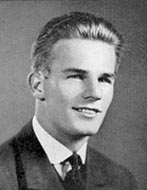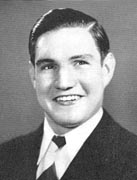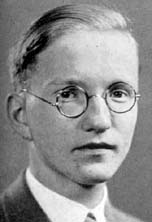| In
Remembrance
The Second World War |
| In
Remembrance
The Second World War |
| Lieutenant Gerald Lawrence Darr
Lt. Jerry Darr was born in 1917 in Burnside, Pennsylvania. He graduated from Cherry Tree High School and entered the College in the class of 1940. An outstanding athlete who later entered the College Sports Hall of Fame, he excelled on several teams. He was co-captain of football as a running  back
but was renowned for his performances as a hurdler who was never defeated
in either the high or low hurdles during his entire four years at Dickinson.
He was also a member of Beta Theta Phi fraternity and a four year participant
in the German Club. He graduated with a bachelor of Philosophy degree
in June, 1940. He married his classmate, Marion Englander, of Carlisle,
on August 17, 1942, eight months after enlisting in the Army Air Corps. back
but was renowned for his performances as a hurdler who was never defeated
in either the high or low hurdles during his entire four years at Dickinson.
He was also a member of Beta Theta Phi fraternity and a four year participant
in the German Club. He graduated with a bachelor of Philosophy degree
in June, 1940. He married his classmate, Marion Englander, of Carlisle,
on August 17, 1942, eight months after enlisting in the Army Air Corps.
He trained in Alabama, Florida, and Mississippi, he received his wings and a commission as second lieutenant in July, 1942. After bomber training, he was assigned to combat duty in the Solomon Islands area of the South Pacific flying B-24 Liberator bombers. He flew numerous combat missions, struggled with malaria, and rose to the rank of aircraft commander. On November 14, 1943, his Liberator disappeared over the island of Bougainville most probably after being hit with enemy fire. No wreckage was sighted during subsequent searches and Darr, along with his crew, was posted as missing. Two years later, the War Department listed him officially as "killed in action." |
| Lieutenant John William Ell
First Lieutenant Ell spent an outstanding four years at the College after graduating from high school in Nanticoke, Pennsylvania. He worked on the Dickinsonian, and as photography editor of the Microcosm. He was a member of Phi Kappa Sigma,  pledging with John Cockey (above), and served as president of the Catholic
Club and of the Belles Lettres Society. He graduated Phi Beta Kappa
and was the recipient of the Patton Prize for 1940.
pledging with John Cockey (above), and served as president of the Catholic
Club and of the Belles Lettres Society. He graduated Phi Beta Kappa
and was the recipient of the Patton Prize for 1940.
He was inducted in August, 1941 and volunteered for the newly forming parachute infantry units. He was commissioned at Fort Benning, Georgia in January 1943 and was posted to England in January, 1944. On D-Day, 1944, his regiment, the 501st of the 101st Airborne Division, landed before dawn in Normandy. Ell was later wounded but had returned to his unit in time for the airborne assault into Holland to seize the Rhine bridges. On September 18, 1944, his platoon was ordered to hold newly seized positions against an enemy counter-attack. While leading this defense, against superior forces, he was killed by mortar fire. For this action, he was awarded the Bronze Star posthumously. He was twenty-six. John Ell was sensitive, dedicated, and intelligent young man. A letter he sent to his parents, now preserved in the Dickinson College Special Collections, from the Normandy battlefields after his baptism of fire, is eloquent testimony to this. |
Egloff von Tippelskirch
 Von
Tippelskirch was another German exchange student who spent the year at
the College and received a degree with the class of 1933. Born in
Charlottenburg on June 5, 1913 in Brandenburg in northern Germany, he attended
boarding school at Dahlen, outside of Berlin. He went on to the Universities
of Berlin and Freiburg, where he took his law examinations, before arriving
in Carlisle. In the words of the Dickinsonian, "a tall and
unassuming boy," he studied American Criminal Law and History while at
the College. He returned to Berlin and ultimately earned his doctorate. Von
Tippelskirch was another German exchange student who spent the year at
the College and received a degree with the class of 1933. Born in
Charlottenburg on June 5, 1913 in Brandenburg in northern Germany, he attended
boarding school at Dahlen, outside of Berlin. He went on to the Universities
of Berlin and Freiburg, where he took his law examinations, before arriving
in Carlisle. In the words of the Dickinsonian, "a tall and
unassuming boy," he studied American Criminal Law and History while at
the College. He returned to Berlin and ultimately earned his doctorate.
He served in the German Army on the Eastern Front where he was captured and died on February, 1946 in a Russian prisoner of war camp. |
|
|
|
|
|
|
|